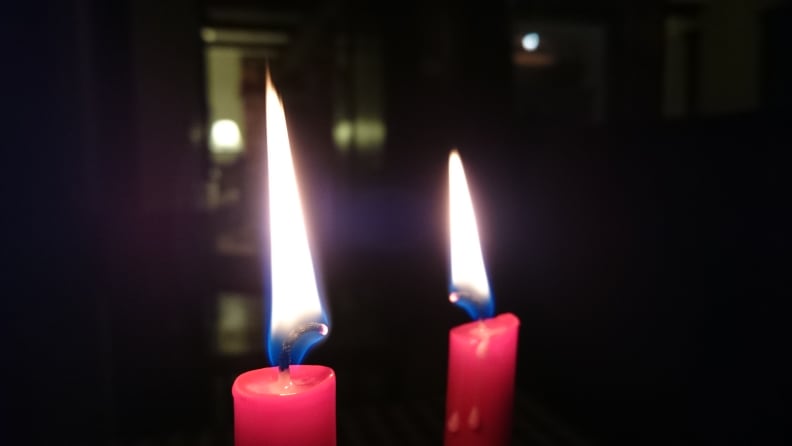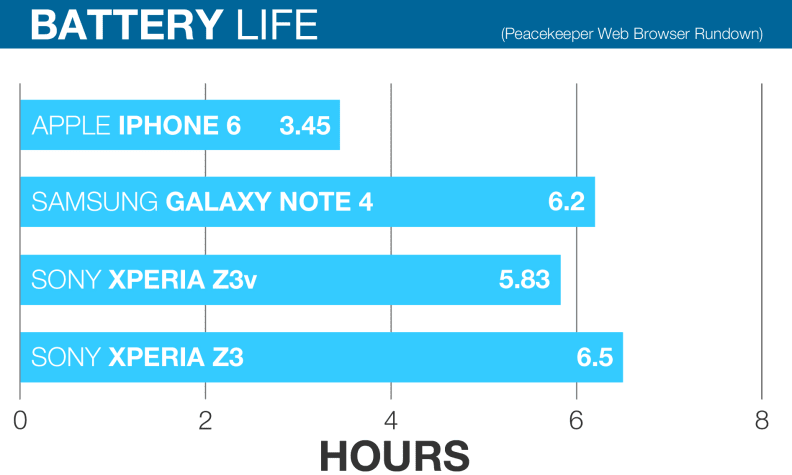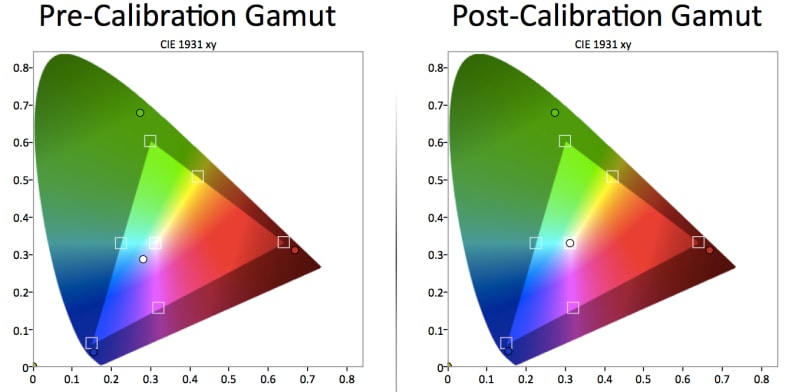Pros
Cons
Point and shoot cameras are the next in line to be felled by the mighty mobile, though up until now using the camera on your phone was less about quality than it was convenience. Smartphones may do it all, but they're certainly not the best solution for capturing important moments.
Sony wants to change how you view the smartphone, and it's bringing the might of its imaging R&D to do it. The brand-new Xperia Z3 ($630 MSRP, off-contract) is the prime example, packing a sensor that's the same size you'd find in most point-and-shoot cameras.
We expected to find the Z3's camera among the best we'd tested in a smartphone. What we didn't expect was that the Z3 itself would be the complete package—the Z3 hangs tough with our top performers in every category, and also brings an incredible battery to the table. The Z3 isn't perfect, but it's a phone that does practically everything, and does it well.
Design
The future, wrapped up in the past.
At first glance, the Xperia Z3 doesn't seem all that modern. It has rounded metal edges with removable port flaps, sandwiched between two practically featureless slabs of glass. It's glossy, reflective, and looks like the prettiest smartphone from 2011. The glass back is good-looking, but it immediately presents handling problems.
It's overly slick, it picks up smudges and prints like nobody's business, and it's far too easy to nick and crack. More than once I set the Z3 down on my wallet, chair, lap, or on a table only for it to slowly and surely slide right off and nearly onto the floor. One of my coworkers had it slide right off his desk, the phone moving ever so slowly to the precipice due to the vibrations of him typing. This is a phone with a death wish.
Turning on the Z3 doesn't do much to assuage the outdated feeling that accompanies the Z3. The icon design looks like something straight from Sony's Playstation 3, with visible jaggies and rounded designs that feel overly large. They're not necessarily ugly, but compared to the flat, minimalist designs that iOS 8 and stock Android 5 Lollipop offer, Sony's designs need some work.
{{ photo_gallery "tour" }}
Once you get over the mediocre first impressions, however, the Z3 just begins to make sense. The slightly narrow 5.2-inch screen cuts excellently between too-large phablets that are difficult to hold and smaller screens that don't show off content quite as well. The phone slips easily into any pocket, and the buttons are in generally sensible places. There's even a dedicated camera button, which instantly calls up the camera app and acts as a physical shutter button.
Even the use of much-maligned port flaps makes sense here. Though it's a pain to remove tiny little flaps just to charge your phone, the Z3 includes rubber gaskets around each. This creates a water-tight seal that, when combined with the hydrophobic coating on the headphone jack, makes the Z3 waterproof and dustproof to around 5 feet. It won't survive extended use and salt water is a big no-no, but you only realize how often you worry about dunking your phone when you don't have to anymore.
Camera
The beginning of the end for point-and-shoots.
It's no secret that the point and shoot camera is becoming an endangered species now that smartphones offer a more convenient solution. However, the mobile market hasn't offered a camera that could compete in image quality with even basic point-and-shoots—not until now, anyways. By packing a 20-megapixel, 1/2.3-inch sensor (the same size as a point and shoot) into the chassis of the Z3, Sony eliminates one of the main performance advantages of your typical compact camera.

That large sensor means low-light photos are tough to top.
This is a huge deal, because with the Z3 it's no longer true that your camera will always be better than the one found on your smartphone. While there isn't any optical zoom or optical image stabilization on the Z3, images will have natural depth of field, higher resolution, and far less noise than any snap taken by almost another smartphone. Though any DSLR will eat the Z3's lunch, you could be forgiven for mistaking a photo taken by the Z3 for one taken by a dedicated camera.
Even the actual act of taking photos or video with your smartphone is a little more forgiving with the Z3 than it is on other Android or iOS phones. Like Windows Phones, there's a physical button that acts as a shutter release/record toggle on the side of the phone. This incentivizes you to hold the phone the right way, while also making it easier to snap photos with gloves on. And while it may not seem like such a huge deal when you're shooting, anyone watching your clips will thank you for not spreading Vertical Video Syndrome.
As for the software, Sony's done what it can with the limited camera API in Android KitKat, providing you with tons of shooting modes and options—far more than we typically see. You can even download a bunch of modules for your camera, adding functionality that isn't there by default. 4K video? Check. Slow motion? Check. Auto cinemagraphs (called motiongraphs by Sony)? You betcha.
When it comes to raw performance numbers, the story gets better and better. In our color accuracy tests the Z3 produced a color error (∆C00 saturation-corrected) of 3.18 and an overall saturation level of 113.3%. That means colors will be a little more vibrant than they were in real life, occasionally pushing blues and purples too far. Photos and video both are tack sharp, however, with the camera resolving over 1,900 line widths per picture height at MTF50. Anything over 1,600 is very good, so the Z3 comes out very well here.

Color oversaturation tends to add pop to your photos, despite not being technically accurate.
Automatic white balance, too, is exceptionally good for a smartphone camera. The Z3 kept errors under 500 kelvins in most lighting conditions and under 800 in warm, incandescent lighting. Even the best cameras often have errors of over 1,500 kelvins under incandescent lighting, so this is quite acceptable.
When shooting video, only the Verizon-variant Z3V and Samsung's Galaxy Note 4 (both of which also shoot 4K video) were able to touch the performance of the Z3. Motion is unbelievably smooth, and that 4K video feature is something special—it nearly outresolved our video sharpness chart in the labs, no small feat for a cellphone camera. If you're looking for sharable clips instead, you can shoot video in 1080p at 60 (or 30) frames per second, or any one of a number of web-friendly formats. You can even livestream to YouTube if you're so inclined.
Add it all up and the Z3 is easily the best smartphone camera we've tested to date. We've been testing cameras for over a decade, however, and—truth be told—we expected Sony to do even better here. Given Sony's prowess in post-processing images to enhance sharpness and preserve accurate colors, we expect significant improvement in the future. As it stands now, the Z3 is about on par with the company's sub-$200 point-and-shoots. But given that Google recently reworked Android's camera API for Android Lollipop to allow for RAW photos and far more back-end control, we hope that Sony will find a way to improve these photos even more.
In Use
Battery life, camera quality, PS4 streaming—you name it the Z3 has got it.
All the best specs in the world don't mean a thing if the phone is frustrating to use, or isn't capable, or doesn't have the features you want. Though the Z3's version of Android isn't the prettiest, it's mostly functional and includes some downright unique features you simply can't get anywhere else.

You'll never miss the shiny metallic power button.
If you are looking for a frills-free experience, we recommend going with a Nexus phone. This is a phone with frills—heck, this is a phone that was built for frills. There's a ton of choice, features, and extras, but Sony's version of Android can be a little overwhelming compared to the cleaner experience of using a stock Android device. This isn't uncommon among Android manufacturers—here's looking at you, Samsung—but it's tiresome nonetheless.
Still, even with the glut of pre-installed Sony apps, the Z3 is a very powerful device. It has full access to everything Android has to offer, and you can always install the Google Now launcher to spruce up the experience a bit. Sony has also promised to bring Android 5.0 (codename Lollipop) to the entire Xperia line in the near future, so these problems may be gone by the time you read this.
To get the most out of the Z3 right now, however, you'll want to be plugged into Sony's existing ecosystem of products. For example, you can control multiple cameras at once with the in-camera Multi Camera app; but only if you have other Sony cameras connected to the same WiFi network.
Additionally, gamers should appreciate the ability to stream gameplay from their PlayStation 4 to their phone. We tested this out over a home WiFi network and were impressed with just how functional the setup was. Controls tend to have a little bit of lag (they're over wireless, after all), but we were able to play even first person shooters like Destiny well enough. If you're a Sony lifer, this is a fantastic phone for you.
Performance
It's fun to watch the goalposts move.
Though the Z3's software isn't the clean, attractive UI that stock Android users are accustomed to, Sony makes up for its lack of polish by making the most of the hardware of the Z3—especially when you're outside. With one of the brightest screens measured in our tests (670.42 cd/m2) the Z3 is visible despite the highly reflective screen—even on very bright days.
If the strategy was to out-muscle every potential problem, it appears that Sony extended this philosophy to the battery, too. Sony crammed a huge 3100mAh battery into the thin chassis of the Z3. Sony then backed that up with some of the most power efficient optimization we've ever seen. Even in our most punishing battery rundown test (web browsing at 400 cd/m2 ), the phone was able to last a full 6 and a half hours. That's just under 20 minutes longer than the next best phone we tested, and almost twice that of the latest iPhones.
If there's a common theme with the Z3 it's that you just don't have to worry about it. With most phones 30% battery remaining is a red flag, a signal you should find the nearest outlet and top up. I brought the Sony home one Friday with 72% battery. After a weekend of some light web browsing, PS4 streaming, music playing, and a few e-mails I returned to the office on Monday with 19% battery. And I left the charger at the office.

The Xperia Z3 blows the other flagship smartphones out of the water when it comes to battery life. It's not even close.
The processor inside the Z3 isn't top of the line, but it's at least market standard. An aging Qualcomm Snapdragon 801 chip more than holds its own against other models when it comes to gaming and basic tasks. While it doesn't stack up well to the Galaxy Note 4 or Apple's latest silicon, the Z3's processor is well-supported by its 3 gigabytes of RAM, so the phone doesn't choke on large tasks.
If there's a weak point in the Z3's design, it's absolutely the screen. It's not bad, per se, it's just the weakest part of its overall performance. To be honest, some of the problems we found in the lab can be corrected a bit through calibration, but the average user isn't going to be able to do this with any degree of certainty, so we only scored the stock settings—right out of the box.

Use these settings for the most accurate colors—if you're okay with harming your peak brightness as a result.
Color is wildly oversaturated with a very cool white point. But it seems like this was intentional; by boosting blues, Sony is able to keep that screen insanely bright, even if the colors aren't perfect. Under stock settings, contrast performance is decent, owing in large part to a retina-melting peak brightness of 670.42 cd/m2 achieved through the aforementioned color tomfoolery. A high black level of 0.58 cd/m2 keeps the contrast ratio a bit reserved at 1155:1, but with a near-ideal transition from black to white, you won't notice anything wrong here.
Once we calibrated the display using the white balance controls, we were able to get that white point back under control, but there were consequences. Color improved somewhat, but contrast suffered heavily—the peak brightness was cut down to 471.45 cd/m2, and overall contrast dropped from 1155:1 to 1025:1. This might not seem like a lot—and by all rights it isn't—but we suggest leaving the display settings well enough alone if you use your phone outdoors a lot. The high peak brightness is going to be much more important there than an accurate white point.

Before calibration, a decent white point is a casualty of boosted blues.
Conclusion
Sony's got the phone to beat in 2014, if you're on T-Mobile.
When you get down to it, there are four things that most people want in a phone: a relatively fast processor, a good-looking display that you can see while outdoors, a great camera, and excellent battery life. In some form or another, most people's ideal phone will nail all four of those. While it might be slicker than a can of grease, the Sony Xperia Z3 is as close to an ideal phone as you can find on the market today.

A physical shutter button makes the phone a true point and shoot.
Ever have something hanging over your head for a couple of days? Something you were worried about that just wouldn't leave the back of your mind? That's how I felt when I went from using the Sony Z3 back to my regular phone. Every trip near the sink, every walk through a rainstorm, every day away from a power outlet felt like a day I'd rather have had the Sony.
Once you adapt to a waterproof, dustproof phone with a battery that just won't quit, it's hard to go back. It's not that my personal phone isn't durable, or that it'll melt if it gets a little wet, but it's just one more thing to worry about. The Sony Z3 isn't perfect, of course; there are more powerful phones, it's currently only available on T-Mobile (The Verizon-only Z3V is closer to the Z2 than this phone), and it's only a matter of time before something bigger and better knocks it off its perch.
But this is a phone that's built to stand the test of time better than most of its competitors. Its battery life is absolutely flooring, its camera is currently the best you'll find on a mobile, and its features are seemingly endless. In a year most flagship phones will feel dated, with degraded batteries that barely last a day with light usage.
In a year or two, the Sony Z3 should still be a great device. It'll still have a long-lasting battery, it'll still have a decent camera, it'll still be waterproof if you take care of it, and it'll still pull off neat party tricks like streaming PS4 games from your console. It's a phone built for the long haul, in more ways than one.
Meet the tester
A seasoned writer and professional photographer, Chris reviews cameras, headphones, smartphones, laptops, and lenses. Educated in Political Science and Linguistics, Chris can often be found building a robot army, snowboarding, or getting ink.
Checking our work.
Our team is here to help you buy the best stuff and love what you own. Our writers, editors, and experts obsess over the products we cover to make sure you're confident and satisfied. Have a different opinion about something we recommend? Email us and we'll compare notes.
Shoot us an email



